Fuji T 30 With 18 55mm Lens Review
Our Verdict
The X-T30 has a couple of treatment quirks that are practically inevitable in a photographic camera this small, and it has no in-torso stabilization, just these are the just faults we can find in a camera with superb external controls, a great 26.1-megapixel sensor, superb autofocus and powerful 4K video recording – and all for the price of regular mid-range photographic camera.
For
- First-class image quality
- Powerful and effective autofocus
- Traditional exposure controls
- Small size
Confronting
- No in-body stabilisation
- Placement of Q push button
Digital Camera Globe Verdict
The 10-T30 has a couple of handling quirks that are practically inevitable in a camera this small, and it has no in-body stabilization, but these are the only faults we can find in a camera with superb external controls, a great 26.1-megapixel sensor, superb autofocus and powerful 4K video recording – and all for the price of regular mid-range camera.
Pros
- +
Excellent image quality
- +
Powerful and effective autofocus
- +
Traditional exposure controls
- +
Small size
Cons
- -
No in-body stabilisation
- -
Placement of Q button
The Fujifilm X-T30 has been dubbed the "Fiddling Behemothic" – a small photographic camera with large performance. Information technology'southward the successor to the X-T20, and it'southward a kind of cut-down version of the company's flagship Ten-T3 model which shares a lot of that camera's technological advances.
The X-T30 is one of the strongest contenders in the APS-C mirrorless camera market. It'south not just one of the best Fujifilm cameras y'all can get right now, only one of the best mirrorless cameras all circular. Its biggest rivals are perhaps the Sony A6400, which lacks the X-T30'south handling only does have a front-facing vlogging screen, and definitely the brand new Nikon Z fifty.
You'd yet selection the X-T3 for speed, handling with bigger lenses and high-end 4K video, but the Ten-T30 is ideal if yous want a sophisticated, loftier-performance mirrorless camera that's also small and not too expensive.
This makes the X-T30 a great little all-round photographic camera that's right at the cutting edge of APS-C mirrorless photographic camera engineering, but cost reductions hateful it'southward at present fashion nether the £i,000/$ane,000 price barrier, fifty-fifty with a 15-45mm kit lens. For a camera this powerful and this well made, it'southward a terrific price.
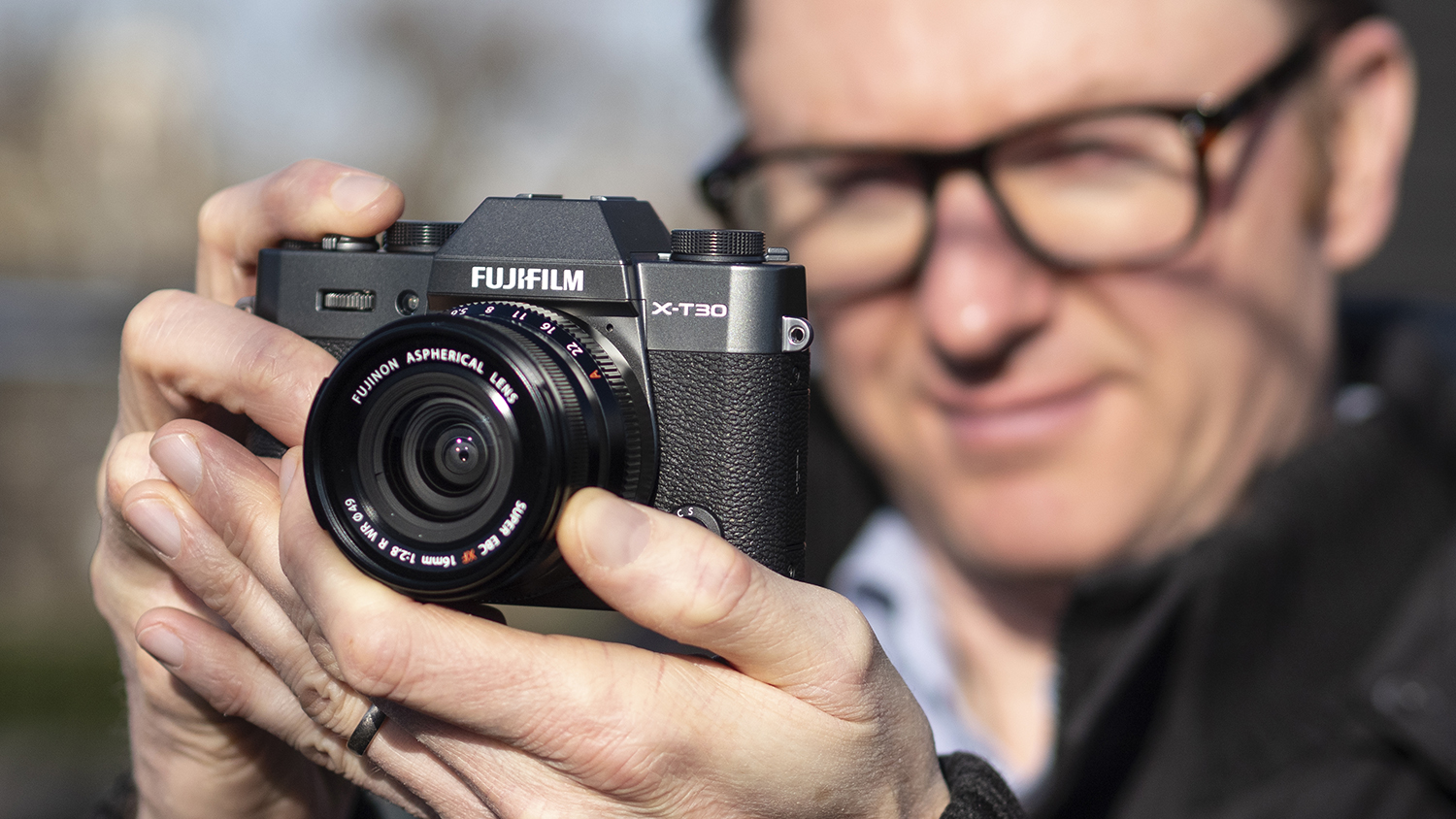
Specifications
Sensor: 26.1MP APS-C X-Trans CMOS 4, 23.5 x 15.6mm
Image processor: X-Processor Pro 4
AF points: two.16 million phase AF pixels, 100% coverage
ISO range: 200 to 12,800 (exp. 100 to 51,200)
Max paradigm size: vi,240 ten 4,160
Metering modes: Multi, spot, average, centre-weighted
Video: 4K DCI/UHD at 30p, 25p, 24p
Viewfinder: EVF, two.36m dots, 100% coverage
Retentivity card: SD / SDHC / SDXC
LCD: 3-inch tilting touchscreen, one.04m dots
Max outburst: 30fps (electronic shutter, 1.25x ingather), 8fps
Connectivity: Wi-Fi, Bluetooth
Size: 118.iv 10 82.viii 10 46.8mm (torso merely)
Weight: 383g (trunk only, with bombardment and carte du jour)
Central features
The Ten-T30 comes with Fujifilm'due south latest 26.1MP X-Trans CMOS iv APS-C image sensor and an 10-Processor Pro four paradigm processor said to exist three times faster than the previous third-generation version in the 10-T20. This new sensor debuted last autumn in the Ten-T3, and its back-illuminated pattern brings improved light-gathering capability and epitome quality.
Some of the biggest changes, however, are to the autofocus system. The 10-T30 at present has 2.16 million phase detection pixels covering 100% of the image surface area. The confront and centre detection has been improved cheers to smaller and more precise tracking areas, and the low-light sensitivity has been improved too – the 10-T30'due south AF can now piece of work in light levels every bit depression every bit -3EV.

The continuous shooting performance has been improved over the previous X-T20 and information technology's now possible to capture frames at 30fps with no viewfinder blackout when using the electronic shutter and the photographic camera'south 1.25x crop fashion. If you apply the mechanical shutter, the meridian speed is 8fps. That's impressive in a camera at this price that's not designed specifically for sports. The Raw buffer chapters at full resolution is pretty modest, though, at effectually 17-18 frames.
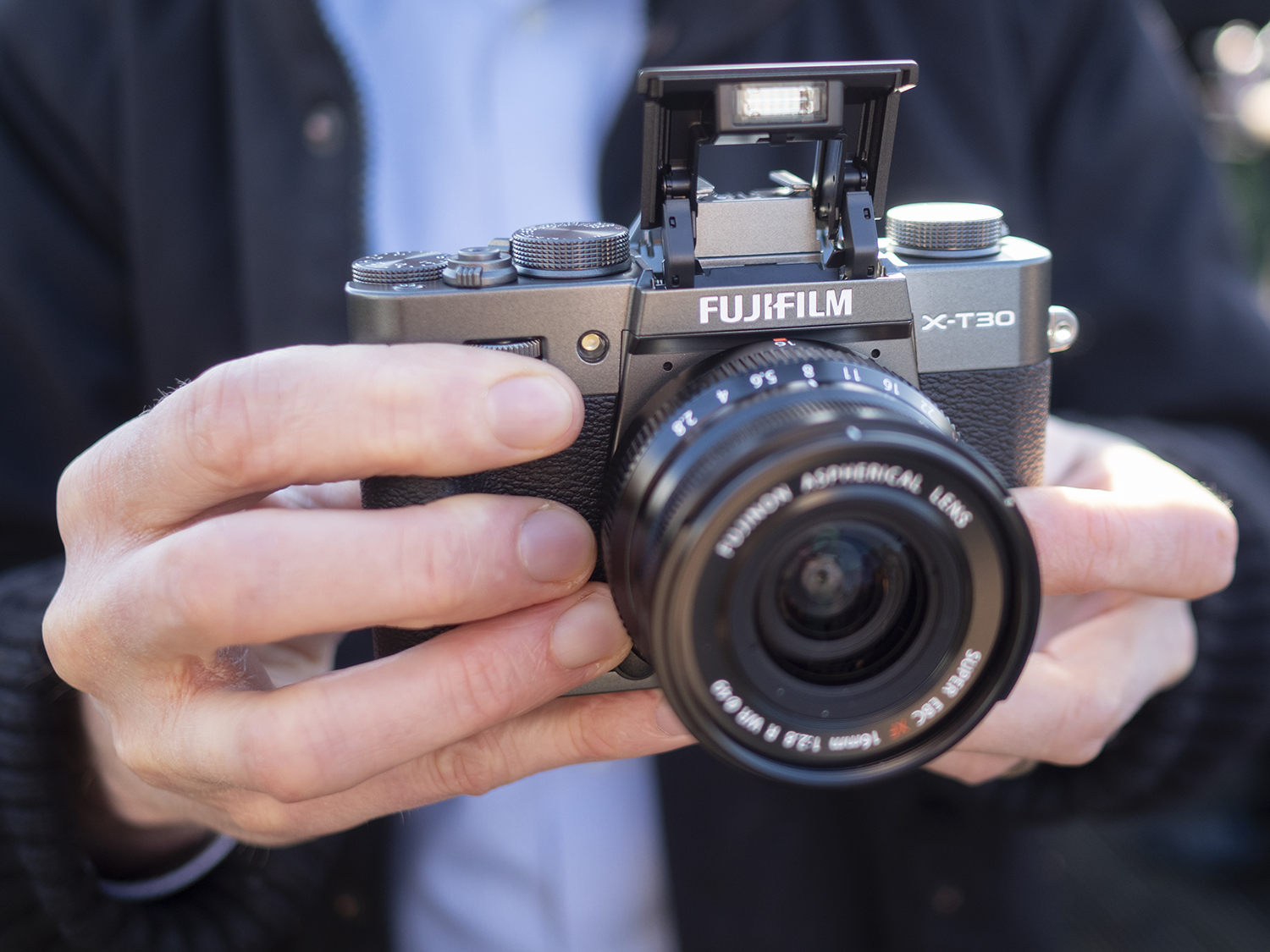
The X-T30 has some pretty impressive video features also. It tin can capture 4K UHD video at 30p, using 'oversampled' 6K capture downsampled to 4K for maximum epitome quality, and it also has Fujifilm's latest ETERNA picture palace moving-picture show simulation mode. The Ten-T30 tin salvage 4:2:0 8-bit video internally or 4:2:2 10-chip via HDMI. In 1080p it tin shoot upward to 60fps or 120fps in High speed rec mode, and information technology too supports the DCI 17:ix format.
The applied science that'south gone into the X-T30 might non be enough to tempt whatsoever owners of the one-time X-T20 to upgrade, but anyone looking for the all-time sub-£1,000/$1,000 camera you can buy right now may have just found it.
Build and handling
The X-T30 looks almost identical to the previous Ten-T20, though the LCD is one.3mm thinner and there's a revised grip shape for better handling. There are differences on the dorsum, as well. The four-way directional buttons on the previous camera are gone, replaced by a new Focus Lever which too handles bill of fare navigation. Information technology makes the dorsum of the photographic camera much less cluttered and you might hardly miss the buttons at all, as well-nigh everyday photographic camera settings can be accessed simply every bit quickly via the Q menu anyway.
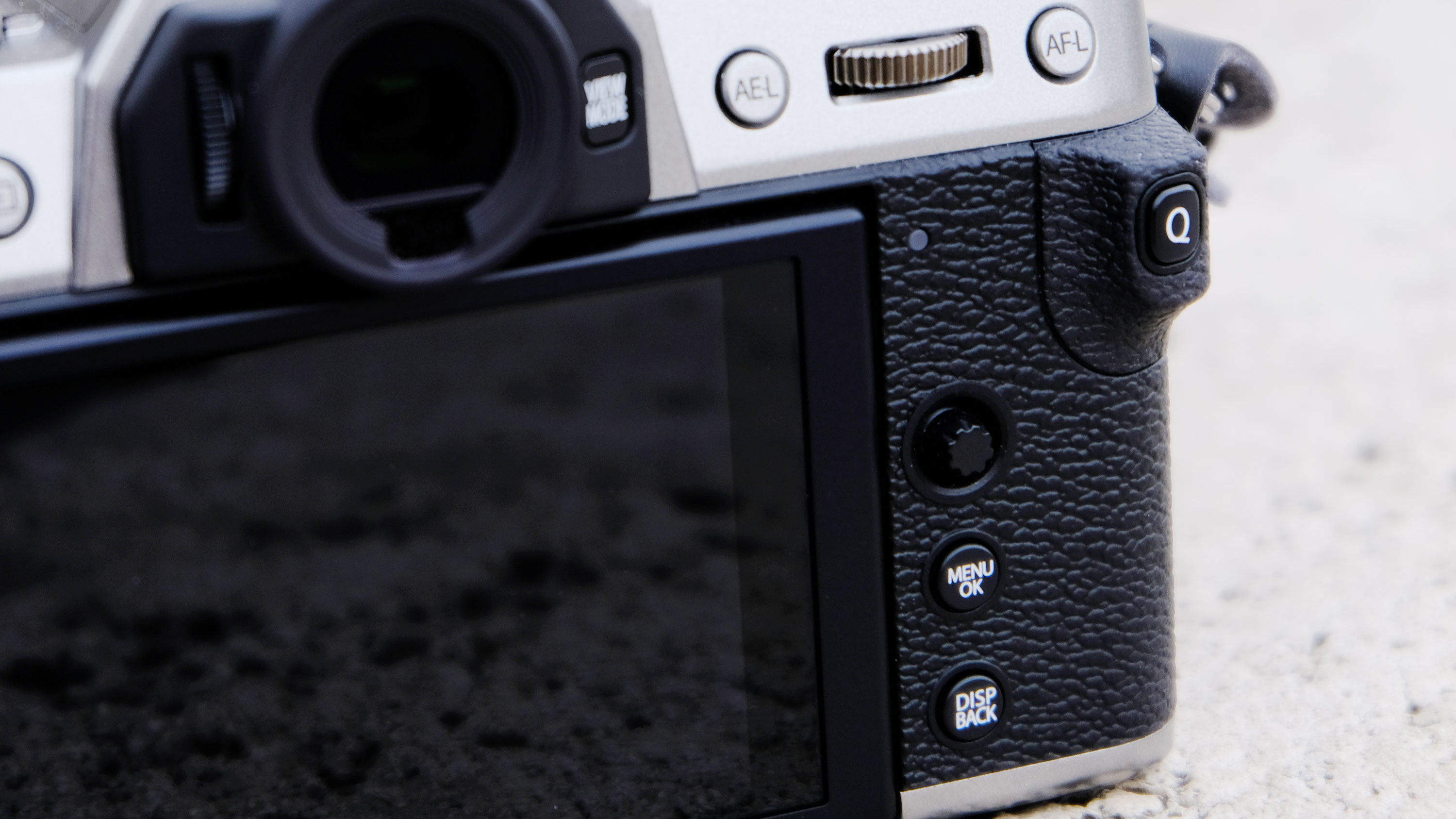
The interactive Q(uick) display works actually well, merely the push button placement acquired u.s. some bug. It'south right on the thumb grip and it'south besides easy to press accidentally as you lot're taking the camera out of a pocketbook or even raising it to your eye – the Q screen pops up correct when you don't want it and yous have to cancel it before you can have a picture. You'll probably adapt and shift your grip unconsciously to avoid this, but information technology could be annoying in the short term.
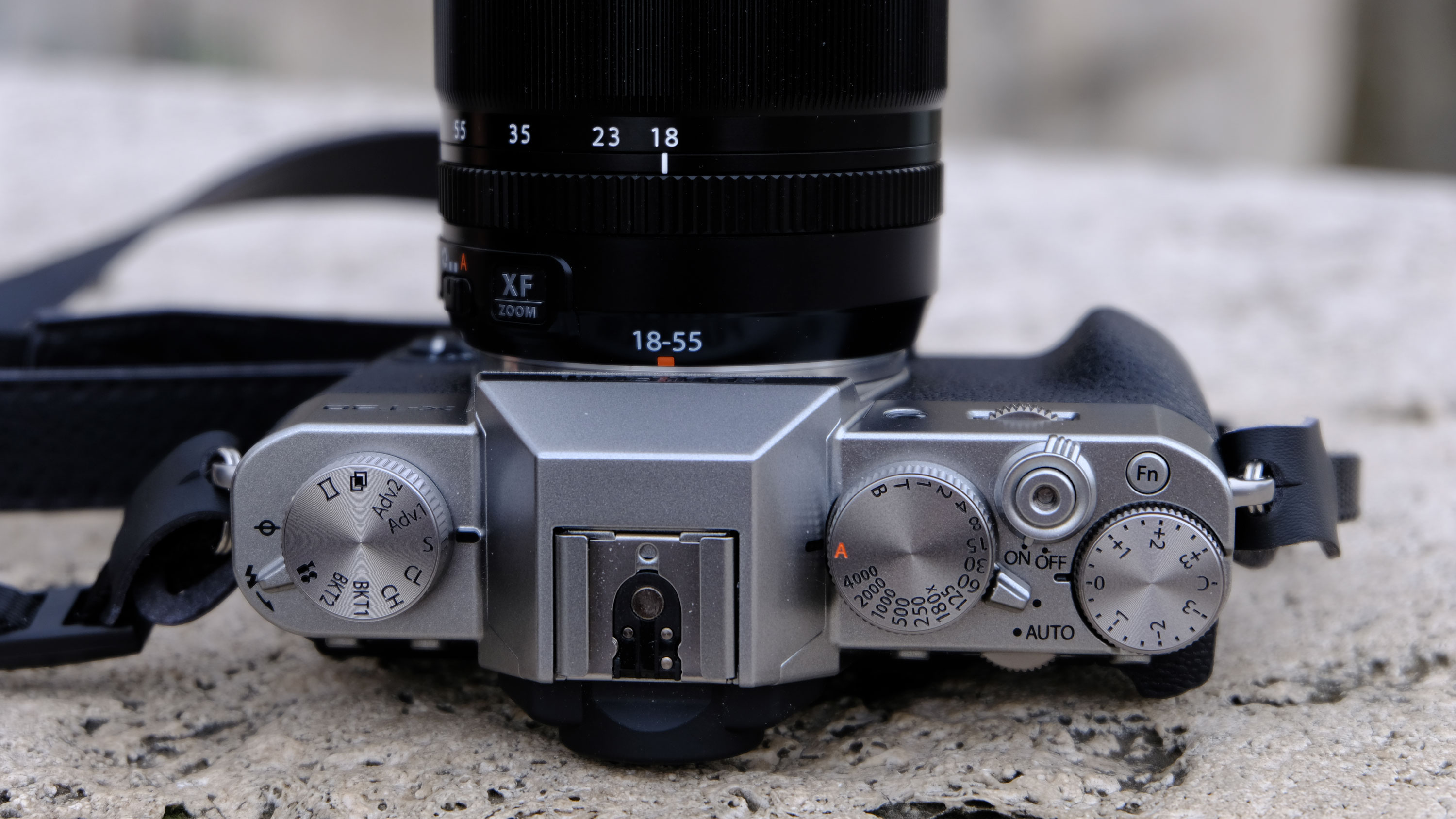
The rear screen has a tilt action but no sideways tilt, so it's great for low or high angle shots with the camera held horizontally, but not then skilful for vertical shots, where you accept to get yourself at eye level with the screen.
The Ten-T30 keeps Fujifilm's characteristic control layout, though, with a shutter speed punch on the tiptop of the photographic camera and lens aperture rings on some (but not all) lenses. Fujifilm's prime lenses and 'crimson bluecoat' zooms have aperture rings, only the 18-55mm f/two.viii-4 kit lens has a switch for car/transmission aperture control and an unmarked discontinuity ring for the latter.
This means there's no manner dial, and you achieve the usual program AE, aperture-priority, shutter-priority and transmission modes using combinations of manual settings and the 'A' settings on the shutter speed and aperture dials. For some, this is going to exist a welcome return to how cameras actually used to work! For others raised on mode dials and command dials, it might take a bit of getting used to.
Performance

The new and improved face up and eye tracking is very constructive, though virtually too constructive at times, as it seems easily distracted by people wandering into the frame when yous're trying to shoot inanimate objects. The downside of all this sophistication is that yous will inevitably accept to spend more time getting familiar with the AF options and choosing and customising them to suit the manner you shoot.


Autofocus performance generally is excellent, though the speed will non depend solely on the photographic camera but on the AF actuators in the lenses themselves. The 18-55mm f/ii.viii-4 kit lens is fast, smoothen and responsive, every bit are other recent Fujifilm lenses, for example, just the older 27mm f/ii.8 pancake prime number will all the same wheeze and whirr during autofocus, but just a shade faster than before!
As e'er, Fujifilm includes a broad range of its historic Film Simulation modes, including Provia/Standard, Velvia/Brilliant, Astia/Soft, Classic Chrome, Pro Neg.How-do-you-do, Pro Neg.Std, Black & White, Black & White+Ye Filter, Black & White+R Filter, Black & White+1000 Filter, Sepia, Acros, Acros+Ye Filter, Acros+R Filter, Acros+G Filter and the new Eterna/Cinema.
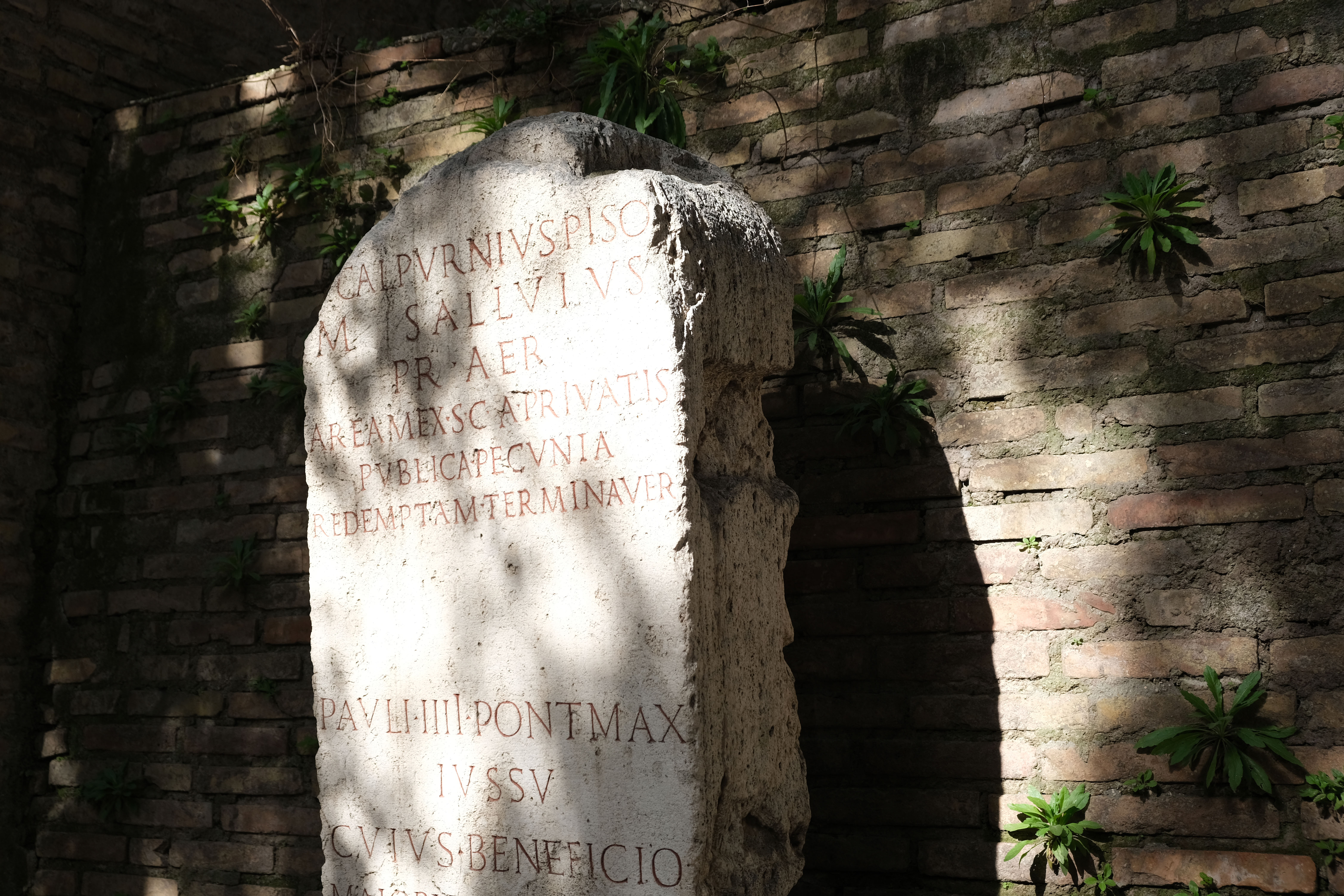


These all create in-camera JPEGs with these profiles practical – if you shoot raw files, you'll need to rely on your raw software to produce the closest simulation, only both Adobe Photographic camera Raw and Capture One Pro practise this very effectively. The Velvia mode offers supersaturated colours and high contrast, Astia offers similar colours but with softer contrast and the Provia mode is more than neutral.
There is more tonal control available if you demand it. The X-T30 offers Fujifilm's expanded dynamic range modes (200% and 400%) plus highlight and shadow contrast controls. With the Film Simulation modes and these boosted tonal adjustments you can create in-photographic camera JPEGs which are very close to an optimum raw file conversion.

Lab tests
We checked the X-T30's lab results against 3 similarly-priced, similarly-sized mirrorless cameras – the Catechism EOS M5, Olympus PEN-F and Sony A6400.
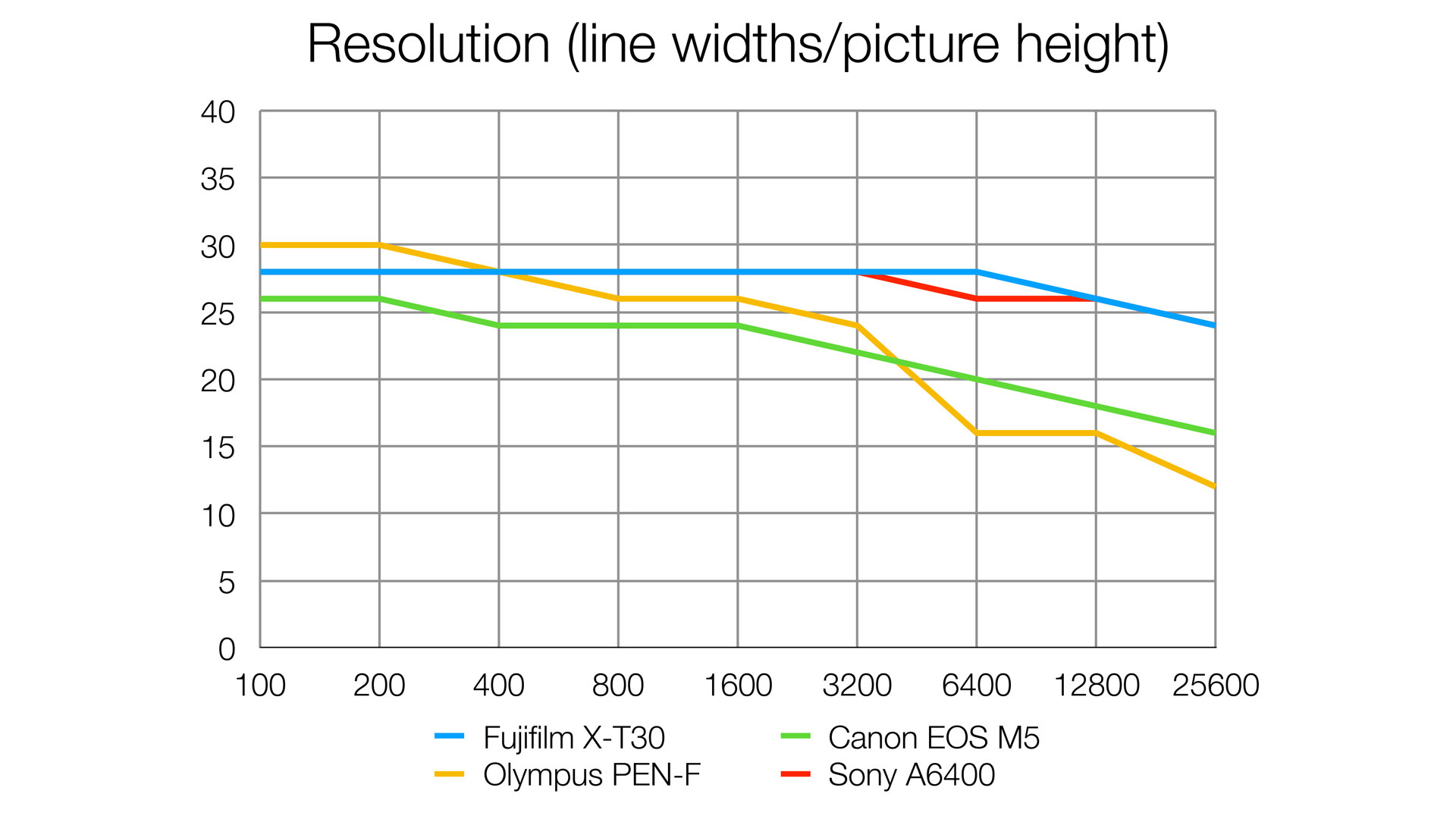
Resolution
The Olympus PEN-F turns in a remarkably good resolution outcome at its lowest ISO setting, but this chop-chop falls at college ISOs and it'due south the X-T30 and Sony A6400 that lead the pack, running cervix and neck until ISO 3200, where the X-T30 edges slightly ahead.

Signal to noise ratio
The Ten-T30 emerged a clear winner for dissonance control in our lab tests, though these results were achieved using the Fujifilm-branded SilkyPix raw converter. Others, including Adobe Photographic camera Raw and Capture One, may give different results.
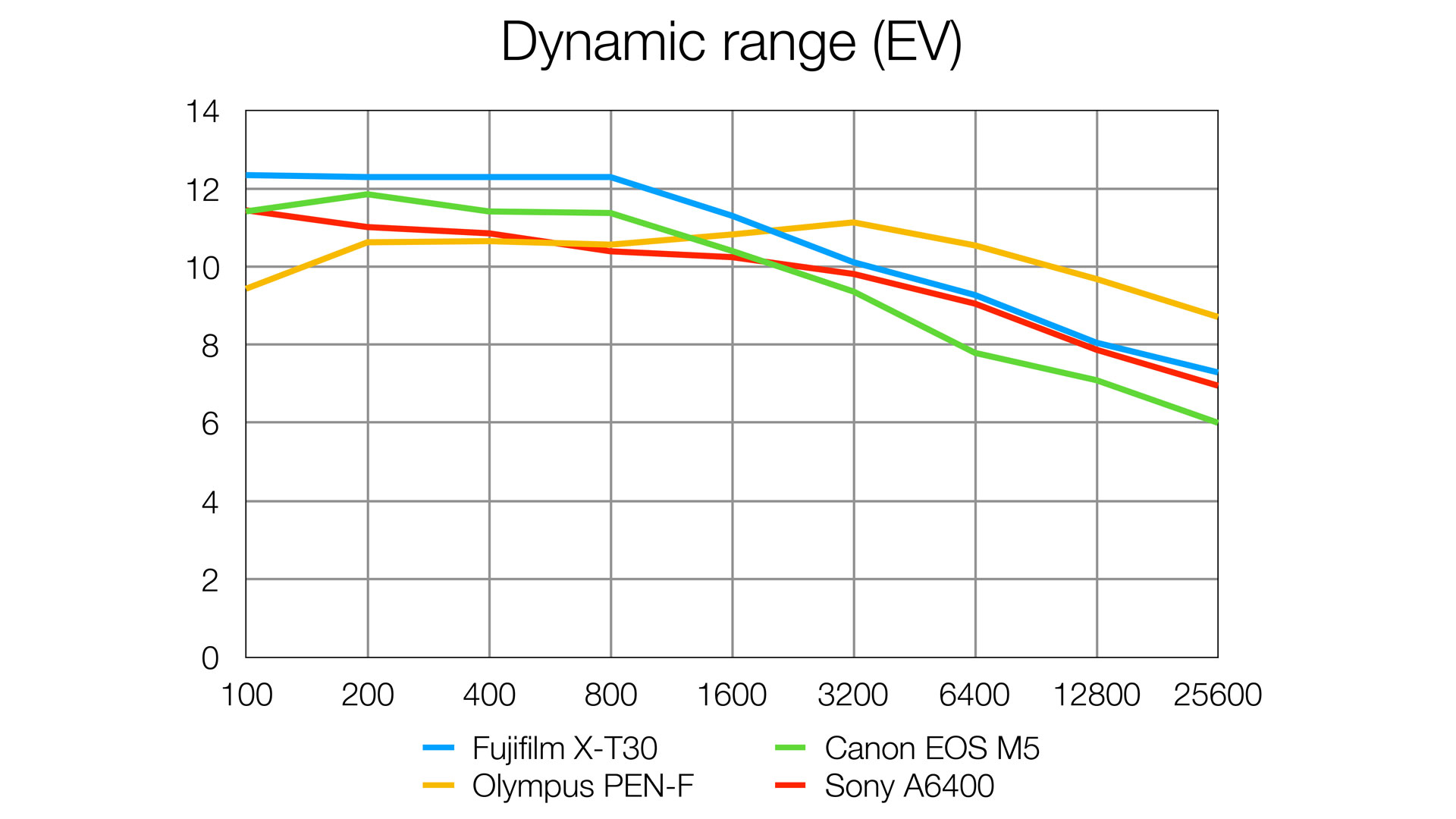
Dynamic range
Up to around ISO 800 the X-T30 displays a slight dynamic range advantage over its rivals, but beyond that it'south the Olympus PEN-F that starts to sneak ahead (the Olympus camera's resolution drops off more than quickly at high ISOs, though).
Verdict
The 10-T30 crams a lot of engineering science and operation into a very pocket-size torso. Sometimes it seems even too minor, equally information technology's nevertheless a little too piece of cake to press buttons by blow, and bigger lenses will inevitably leave information technology feeling front-heavy.
Its continuous shooting speed and autofocus functioning make information technology great for sports and action subjects, but a bigger camera like the Ten-T3 would be better still – and the X-T3 has a larger memory buffer. Similarly, the X-T30's 4K video is very good indeed, but the 10-T3'south is amend, though neither camera has a front end-facing screen for filming yourself while vlogging.

Forth with the X-T3, this is currently the highest-resolution APS-C mirrorless photographic camera y'all can buy. It'due south also one of the smallest, most powerful and about versatile. Fujifilm'south closest competition here is the Sony A6400/6500, just the Sony does not take the X-T30'due south blueprint finesse, traditional photographic controls, EVF and screen quality or even lens range (particularly if you lot like prime lenses).
And so while nosotros can criticise aspects of the X-T30's features and handling here and there, it is actually just nitpicking. At this price, there is cypher else to touch it for its all-round alloy of performance, features, controls, handling, or even paradigm quality – even if you lot extend your search to include DSLRs.

The X-T30 is available now in blackness and silver, merely there volition be a new Charcoal Silverish finish arriving in May 2019. Yous can buy the camera body-but (useful if you already have a Fujifilm organisation), with the meaty Fujinon XC 15-45mm power-zoom lens or the very good but more expensive Fujinon XF 18-55mm.
Rivals
Nosotros've picked three central rivals for the Fujifilm X-T30 both for our lab tests and for this comparison.

Canon EOS M5
It's aimed at the same kind of college-end enthusiast market place, just the EOS M5 is getting quite long in the molar now and can't match the 10-T30'southward resolution, autofocus or video performance. It has dropped considerably in price, though.
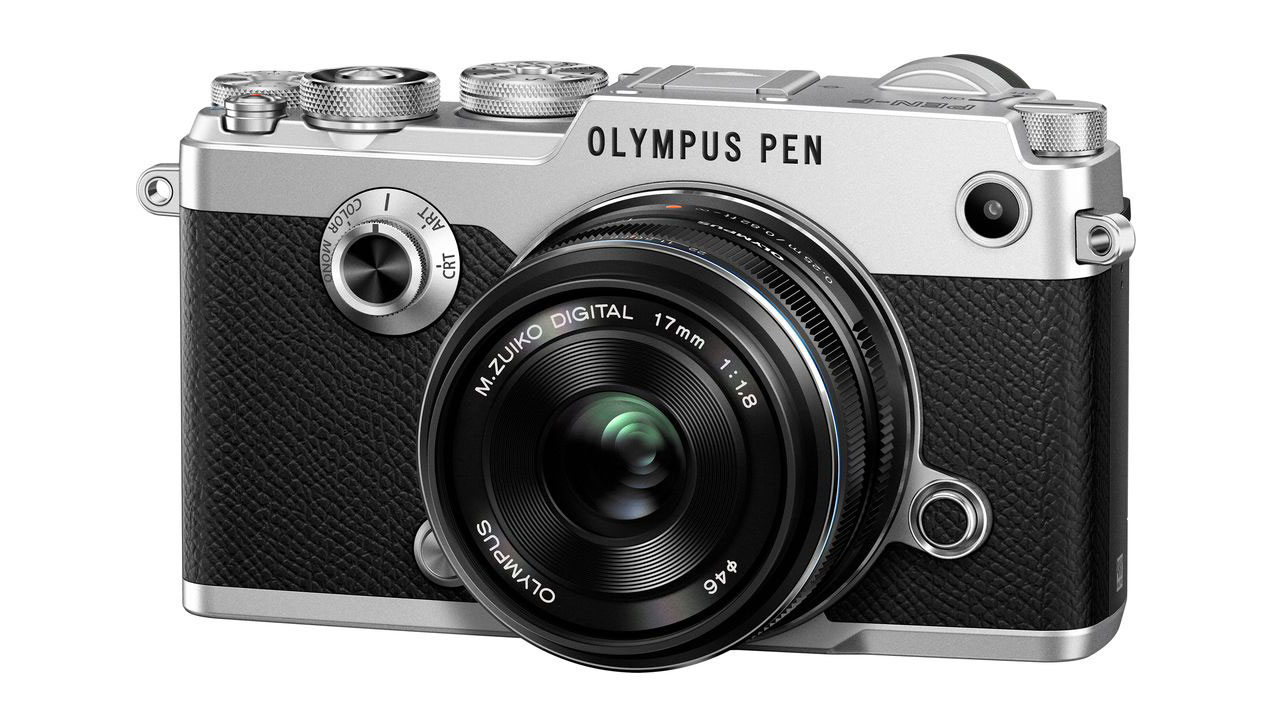
Olympus PEN-F
Don't be fooled past the smaller Micro Four Thirds sensor – the PEN-F delivers similar levels of sharpness to its APS-C rivals, has an appealing retro design, fully-articulating rear screen and in-body stabilisation. It costs enough, though, and doesn't take 4K video.

Sony A6400
The A6400 shoots high-quality 4K video and has a 180-degree flip-frontwards screen which is brilliant for vlogging. It'due south an old camera design, though, and less appealing for stills photographers than the X-T30.
Read more:
• The best Fujifilm cameras
• DSLR vs mirrorless cameras: How exercise they compare?
• The best camera for beginners
• The best mirrorless cameras
arizmendiourprome1954.blogspot.com
Source: https://www.digitalcameraworld.com/uk/reviews/fujifilm-x-t30-review
0 Response to "Fuji T 30 With 18 55mm Lens Review"
Post a Comment